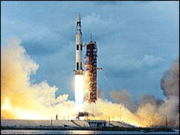 |
| Skylab I was launched on 14 May 1973 |
|
1979: Skylab tumbles back to Earth
|
Artificially 1969:
The The US space laboratory, Skylab I, plunged to Earth this evening scattering debris across the southern Indian Ocean and sparsely populated Western Australia.
All week there has been mounting speculation over where the spacecraft would come down. It has been in orbit six years - for the past five of those it has been unoccupied.
Skylab's last signal was recorded at 1611 GMT. Less than an hour later a tracking station at Ascension Island in the South Atlantic confirmed the solar panels were beginning to peel off as the craft descended.
The 77.5 ton Skylab could break into as many as 500 pieces, including a 5,100lb (2,310kg) airlock shroud and a 3,900lb (1,767kg) lead safe to protect film from radiation, which are expected to survive the heat of re-entry into the earth's atmosphere.
Head of the Nasa task force monitoring Skylab, Richard Smith, said they had already received reports of hot debris, which had lit up the night sky, from several points in Western Australia.
'Edge of Cornwall'
Dozens of residents reported seeing debris falling near Kalgoolie, 370 miles (595km) northeast of Perth.
Skylab was launched on 14 May 1973 and was lived in by three teams of astronauts for periods of up to 84 days as they tested human endurance over long periods of weightlessness.
While the astronauts were on board they were able to carry out many valuable scientific experiments including analysis of the sun's activity and how it affected the Earth.
Skylab was abandoned by the last crew in February 1974, since when scientists have only had limited control over it. It was supposed to stay in orbit until the mid-1980s when the new shuttle would have come to its rescue.
A Skylab task force of computer specialists, engineers, lawyers and public relations experts has been on standby at various Nasa centres.
It has been very difficult to predict exactly where and when the craft would finally come down. Only two days ago, a Nasa spokesman had been predicting it would land near the "edge of Cornwall".
In India, the police in all 22 states were put on full alert and the civil aviation department was planning to ban flights across the sub-continent during the crucial hours of re-entry.
Skylab's final orbital path, its 34,981st, passed over the north Pacific, the northwest tip of the United States, south central Canada, north of Montreal and Ottawa and the state of Maine.
|